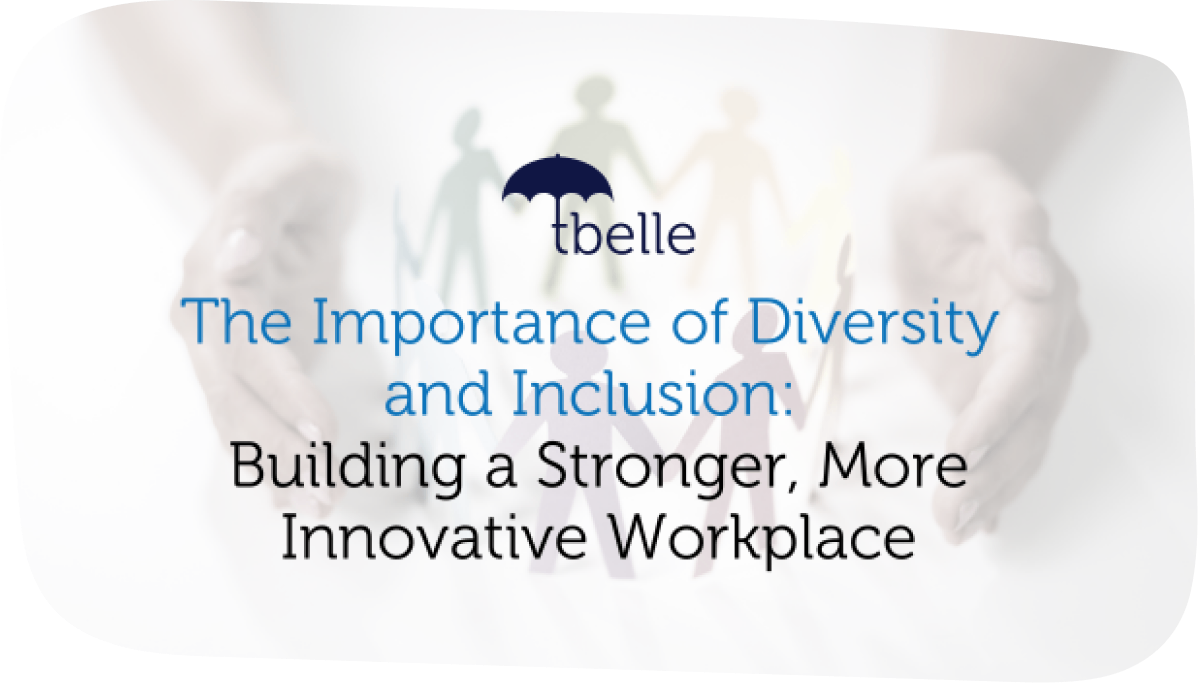
Tbelle Insight:
According to a Harvard Business Review study, companies with diverse teams are 45% more likely to report growth in market share.
With the rapid evolution of the business environment today, comes a growing recognition of the need for companies to implement strategic initiatives to ensure overall success. In the same way that diversity and inclusion (D&I) now are more than just moral imperatives—they are key drivers of success. Companies that embrace diverse perspectives and foster inclusive cultures consistently outperform their competitors. In fact, a study by Harvard Business Review found that companies with diverse teams are 45% more likely to report growth in market share.
As globalisation and shifting societal norms continue to reshape the workforce, the importance of creating diverse, inclusive environments has become crucial not only for business growth but also for cultivating innovation, improving employee satisfaction, and contributing to a more equitable society.
Understanding Diversity and Inclusion (D&I)
Diversity is defined as the representation of various identities, including cultures, genders, religions, ethnicities, disabilities, education, and sexual orientations, and how they interact. Diversity in the workplace means having a team that includes individuals from various backgrounds and national origins.
“The world is becoming more diverse.” As societies continue to evolve, a growing number of countries are experiencing significant demographic shifts. According to global data, a median of 69% of people in surveyed nations believe their country has become more diverse over the past 20 years.
This increasing diversity is reshaping communities, workplaces, and industries, creating new opportunities for businesses that embrace inclusivity and adapt to the changing global complexities. Companies that recognise and leverage this diversity are better positioned to thrive in the modern, interconnected world.
Inclusion, on the other hand, Inclusion means embracing, utilising, and respecting diversity in various environments. It involves accepting and treating individuals from diverse backgrounds equally, ensuring they feel valued and that they belong.
In the workplace, inclusion pertains to the strategies and procedures organisations implement to integrate everyone, ensuring their differences coexist beneficially. It is the deliberate effort to create an environment where all employees feel valued, respected, and empowered to contribute fully. It’s about ensuring that diverse voices are heard, and every individual feels a sense of belonging.
Together, diversity and inclusion foster innovation, improve employee engagement, and enhance overall business success. As societal expectations for fairness and equity grow, the need for inclusive workplaces is becoming more urgent.
Importance of Diversity and Inclusion
One of the most powerful arguments for diversity and inclusion (D&I) is its role in driving innovation. Diverse teams are more creative because they bring a variety of perspectives and experiences to problem-solving.
New data shows that diversity drives innovation and market growth, emphasising the need for executives to embrace and embody the value of differences. A research with 1,800 professionals, and numerous focus groups and interviews, found out that companies promoting diversity in leadership out-innovate and out-perform others, with 70% of the respondents reporting that the firm captured a new market.
When employees from different backgrounds come together, they challenge conventional thinking and spark new ideas, leading to increased creativity, better problem-solving, and ultimately driving innovation and growth within the organisation.
Diversity doesn’t just fuel creativity; it also enhances decision-making. A published research concludes that “as the diversity of teams increases so does the chance of making better decisions”. In fact most diverse teams according to the study made better decisions 87% of the time.
This is mostly because diverse perspectives reduce the likelihood of groupthink, encourage deeper analysis, and result in more comprehensive solutions. The same study above reveals that inclusive decision making delivers better decisions, with high statistical confidence.

Inclusion plays a crucial role in improving employee engagement and retention. When employees feel valued and respected, they are more satisfied with their jobs and are less likely to leave. As Matt Tenney, a leadership speaker and an author explains, workplace diversity and inclusion boost employee satisfaction and engagement by creating a positive, psychologically safe environment where employees feel a sense of belonging and are empowered to perform at their best.
He also continues that, when employees are satisfied that their employer is genuinely committed to fostering a diverse and inclusive workplace, they are twice as engaged as those who are not, based on statistical data.
How to Create a Truly Diverse and Inclusive Workplace
Creating a truly diverse and inclusive workplace starts with strong leadership commitment and accountability. Leaders must be dedicated to diversity and inclusion, setting clear and measurable goals that resonate across the entire organisation. These goals should be supported by Key Performance Indicators (KPIs) and visible accountability frameworks that not only encourage leaders to embrace D&I but to actively embody and live by these values in every aspect of their roles.
According to an Inclusion & Diversity Acceleration organisation—Emberin, an Inclusive Leadership Commitment Journey can help support leaders in taking ownership of their commitment to diversity and inclusion, and to provide a structured framework for creating real change within organisations. This begins by forming cohorts of leaders within the organisation who will embark on a journey of real conversations centred on each quadrant of a leadership model. More information can be found here.
Additionally, inclusive hiring and promotion practices are equally important, as companies should broaden job descriptions to attract diverse candidates and ensure transparent promotion processes that offer equal opportunities for advancement. Research shows that inclusive hiring practices are essential for building a diverse, successful workplace, driving financial success, fostering innovation, and retaining top talent.

Ongoing training and education are also crucial in reducing unconscious bias and enhancing cultural competency, with many organisations implementing D&I programs to support these goals. In fact, a study reveals that 92 percent of the surveyed leaders agree that a strategic workforce education program is key to meaningfully achieving a company’s diversity and inclusion goals.
Finally, cultivating an inclusive culture requires continuous efforts beyond policies, such as fostering a sense of belonging through Employee Resource Groups (ERGs), providing safe spaces for dialogue, and promoting respect at every level of the organisation.
Employee resource groups, according to experts, connect underrepresented groups with the broader company, offering members growth opportunities. These groups are not exclusive and welcome anyone committed to advocating for inclusivity.
What Seem Like D&I But are Actually Not
Many organisations adopt policies or practices that may appear progressive but, in reality, do little to drive meaningful change, in their effort to be D&I-centred companies. Here are some common missteps in D&I initiatives that can ultimately hinder progress:
Tokenism is the practice of making a symbolic effort to include individuals from underrepresented groups, often by hiring or promoting a minimal number of people from these groups.
Token hires, often meant to create a more “diverse” appearance, do not contribute to true inclusivity or equitable opportunity. According to a professional development group, tokenization does not work in anyone’s favour, as the individual being tokenized often feels both undervalued and overexposed.
Implicit Bias Training involves teaching our mindsets to approach others as individuals or colleagues and not as culturally stereotype projections and acknowledging unconscious racial biases.
Does implicit bias training work?
According to a Business Harvard Review article, the short answer is not really. They suggest that while anti-bias training can be a part of the solution to workplace bias, numerous studies show that such training alone does not effectively reduce bias, change behaviour, or improve the workplace environment.
Measuring diversity metrics, such as the percentage of minority hires, is a common practice, but without holding leaders accountable for creating an inclusive culture, these metrics become empty numbers.
Real accountability means linking D&I goals to performance reviews, promotions, and compensation for leaders, making diversity a true organisational priority rather than a check-the-box exercise.
Celebrating diversity days—such as Black History Month, International Women’s Day, or Pride Month—without a sustained commitment to support these groups throughout the year can come off as performative. It’s important for companies to integrate D&I into their daily practices rather than limiting it to single-day or month-long observances.
“Diversity is being invited to the party; inclusion is being asked to dance.” – Vernā Myers
A diverse workforce doesn’t automatically translate to an inclusive environment. It’s not enough to simply have a variety of backgrounds represented; inclusion means actively ensuring all voices are heard, valued, and empowered.
True inclusivity requires intentional actions such as equitable access to opportunities, inclusive decision-making processes, and a zero-tolerance policy for exclusionary behaviour.
Embracing Diversity and Inclusion in the Workplace
The positive impact of diversity and inclusion is significant and far-reaching.
diversity and inclusion is significant and far-reaching.
Diverse companies, according to Deloitte,enjoy 2.3 times higher cash flow per employee, illustrating the tangible financial benefits of fostering diversity and inclusion. This proves that diversity and inclusion are no longer optional; they are essential for building a stronger, more innovative workplace.
Companies that embrace D&I enhance their ability to innovate, improve employee engagement, and create a more equitable society. However, achieving true diversity and inclusion requires more than just hiring diverse talent—it demands strong leadership commitment, inclusive policies, ongoing education, and a culture that values every individual’s contribution.
As the global workforce becomes increasingly diverse, businesses that prioritise D&I will be better positioned for long-term success and social impact. Now is the time for organisations to take proactive steps toward creating inclusive environments that empower their teams and drive innovation.










